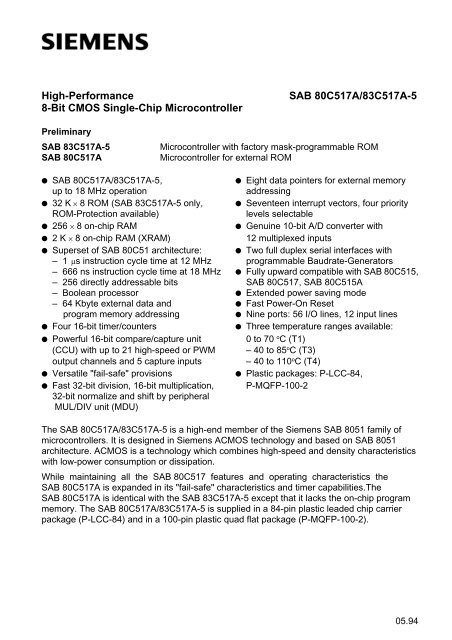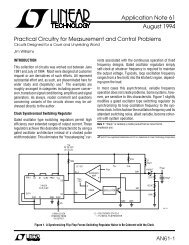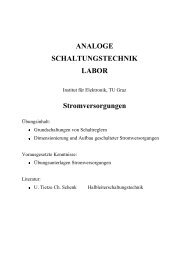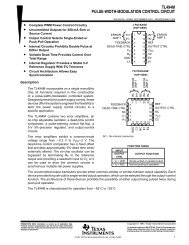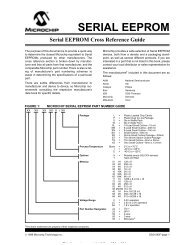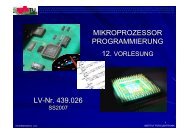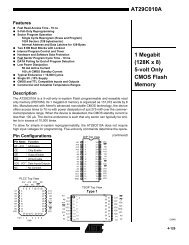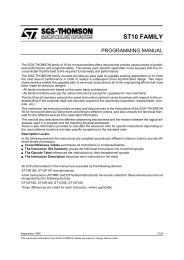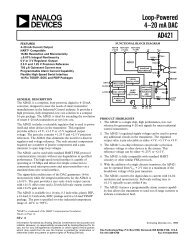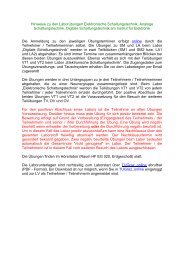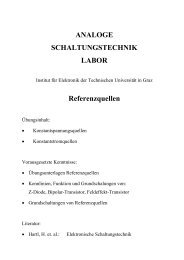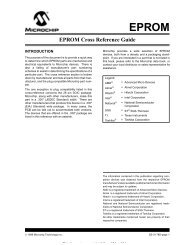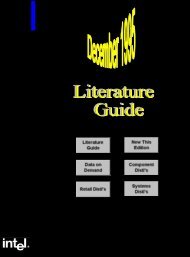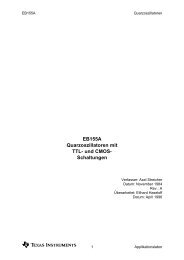High-Performance SAB 80C517A/83C517A-5 8-Bit CMOS Single ...
High-Performance SAB 80C517A/83C517A-5 8-Bit CMOS Single ...
High-Performance SAB 80C517A/83C517A-5 8-Bit CMOS Single ...
You also want an ePaper? Increase the reach of your titles
YUMPU automatically turns print PDFs into web optimized ePapers that Google loves.
<strong>High</strong>-<strong>Performance</strong>8-<strong>Bit</strong> <strong>CMOS</strong> <strong>Single</strong>-Chip Microcontroller<strong>SAB</strong> <strong>80C517A</strong>/<strong>83C517A</strong>-5Preliminary<strong>SAB</strong> <strong>83C517A</strong>-5<strong>SAB</strong> <strong>80C517A</strong>Microcontroller with factory mask-programmable ROMMicrocontroller for external ROM● <strong>SAB</strong> <strong>80C517A</strong>/<strong>83C517A</strong>-5,● Eight data pointers for external memoryup to 18 MHz operationaddressing● 32 K × 8 ROM (<strong>SAB</strong> <strong>83C517A</strong>-5 only, ● Seventeen interrupt vectors, four priorityROM-Protection available)levels selectable● 256 × 8 on-chip RAM● Genuine 10-bit A/D converter with● 2 K × 8 on-chip RAM (XRAM)12 multiplexed inputs● Superset of <strong>SAB</strong> 80C51 architecture: ● Two full duplex serial interfaces with– 1 µs instruction cycle time at 12 MHz programmable Baudrate-Generators– 666 ns instruction cycle time at 18 MHz ● Fully upward compatible with <strong>SAB</strong> 80C515,– 256 directly addressable bits <strong>SAB</strong> 80C517, <strong>SAB</strong> 80C515A– Boolean processor ● Extended power saving mode– 64 Kbyte external data and ● Fast Power-On Resetprogram memory addressing● Nine ports: 56 I/O lines, 12 input lines● Four 16-bit timer/counters● Three temperature ranges available:● Powerful 16-bit compare/capture unit 0 to 70 o C (T1)(CCU) with up to 21 high-speed or PWM – 40 to 85 o C (T3)output channels and 5 capture inputs – 40 to 110 o C (T4)● Versatile "fail-safe" provisions● Plastic packages: P-LCC-84,● Fast 32-bit division, 16-bit multiplication, P-MQFP-100-232-bit normalize and shift by peripheralMUL/DIV unit (MDU)The <strong>SAB</strong> <strong>80C517A</strong>/<strong>83C517A</strong>-5 is a high-end member of the Siemens <strong>SAB</strong> 8051 family ofmicrocontrollers. It is designed in Siemens A<strong>CMOS</strong> technology and based on <strong>SAB</strong> 8051architecture. A<strong>CMOS</strong> is a technology which combines high-speed and density characteristicswith low-power consumption or dissipation.While maintaining all the <strong>SAB</strong> 80C517 features and operating characteristics the<strong>SAB</strong> <strong>80C517A</strong> is expanded in its "fail-safe" characteristics and timer capabilities.The<strong>SAB</strong> <strong>80C517A</strong> is identical with the <strong>SAB</strong> <strong>83C517A</strong>-5 except that it lacks the on-chip programmemory. The <strong>SAB</strong> <strong>80C517A</strong>/<strong>83C517A</strong>-5 is supplied in a 84-pin plastic leaded chip carrierpackage (P-LCC-84) and in a 100-pin plastic quad flat package (P-MQFP-100-2).05.94
<strong>SAB</strong> <strong>80C517A</strong>/<strong>83C517A</strong>-5Logic SymbolSemiconductor Group 4
<strong>SAB</strong> <strong>80C517A</strong>/<strong>83C517A</strong>-5The pin functions of the <strong>SAB</strong> <strong>80C517A</strong> are identical with those of the <strong>SAB</strong> 80C517/80C537 withone exception:Typ <strong>SAB</strong> <strong>80C517A</strong> <strong>SAB</strong> 80C517/80C537P-LCC-84, Pin 60P-MQFP-100-2,Pin 36HWPDN.C.Pin Configuration(P-LCC-84)Semiconductor Group 5
<strong>SAB</strong> <strong>80C517A</strong>/<strong>83C517A</strong>-5Pin Configuration(P-MQFP-100-2)Semiconductor Group 6
<strong>SAB</strong> <strong>80C517A</strong>/<strong>83C517A</strong>-5Pin Definitions and FunctionsSymbol Pin Number I/O *) FunctionP-LCC-84P-MQFP-100-2P4.0 – P4.7 1– 3, 5 – 9 64 - 66,68 - 72I/O Port 4is a bidirectional I/O port with internalpull-up resistors. Port 4 pins that have 1s written to them are pulled high by theinternal pull-up resistors, and in thatstate can be used as inputs. As inputs,port 4 pins being externally pulled lowwill source current (I IL, in the DC characteristics)because of the internal pullupresistors.This port also serves alternate comparefunctions. The secondary functions areassigned to the pins of port 4 as follows:– CM0 (P4.0): Compare Channel 0– CM1 (P4.1): Compare Channel 1– CM2 (P4.2): Compare Channel 2– CM3 (P4.3): Compare Channel 3– CM4 (P4.4): Compare Channel 4– CM5 (P4.5): Compare Channel 5– CM6 (P4.6): Compare Channel 6– CM7 (P4.7): Compare Channel 7PE/SWD 4 67 I Power saving modes enable StartWatchdog TimerA low level on this pin allows the softwareto enter the power down, idle andslow down mode. In case the low levelis also seen during reset, the watchdogtimer function is off on default.Use of the software controlled powersaving modes is blocked, when this pinis held on high level. A high level duringreset performs an automatic start of thewatchdog timer immediately after reset.When left unconnected this pin is pulledhigh by a weak internal pull-up resistor.* I = InputO = OutputSemiconductor Group 7
<strong>SAB</strong> <strong>80C517A</strong>/<strong>83C517A</strong>-5Pin Definitions and Functions (cont’d)Symbol Pin Number I/O *) FunctionP-LCC-84P-MQFP-100-2RESET 10 73 I RESETA low level on this pin for the duration ofone machine cycle while the oscillator isrunning resets the <strong>SAB</strong> <strong>80C517A</strong>. Asmall internal pull-up resistor permitspower-on reset using only a capacitorconnected to V SS .V AREF 11 78 Reference voltage for the A/D converter.V AGND 12 79 Reference ground for the A/Dconverter.P7.7 -P7.0 13 - 20 80 - 87 I Port 7is an 8-bit unidirectional input port. Portpins can be used for digital input, ifvoltage levels meet the specified inputhigh/low voltages, and for the lower 8-bit of the multiplexed analog inputs ofthe A/D converter, simultaneously.* I = InputO = OutputSemiconductor Group 8
<strong>SAB</strong> <strong>80C517A</strong>/<strong>83C517A</strong>-5Pin Definitions and Functions (cont’d)Symbol Pin Number I/O *) FunctionP-LCC-84P-MQFP-100-2P3.0 - P3.7 21 - 28 90 - 97 I/O Port 3is a bidirectional I/O port with internal pullupresistors. Port 3 pins that have 1 swritten to them are pulled high by theinternal pull-up resistors, and in that statecan be used as inputs. As inputs, port 3pins being externally pulled low will sourcecurrent (I IL, in the DC characteristics)because of the internal pull-up resistors.Port 3 also contains the interrupt, timer,serial port 0 and external memory strobepins that are used by various options. Theoutput latch corresponding to a secondaryfunction must be programmed to a one (1)for that function to operate.The secondary functions are assigned tothe pins of port 3, as follows:– R × D0 (P3.0): receiver data input(asynchronous) or data input/output(synchronous) of serial interface– T × D0 (P3.1): transmitter data output(asynchronous) or clock output(synchronous) of serial interface 0– INT0 (P3.2): interrupt 0 input/timer 0gate control– INT1 (P3.3): interrupt 1 input/timer 1gate control– T0 (P3.4): counter 0 input– T1 (P3.5): counter 1 input– WR (P3.6): the write control signallatches the data byte from port 0 into theexternal data memory– RD (P3.7): the read control signalenables the external data memory toport 0* I = InputO = OutputSemiconductor Group 9
<strong>SAB</strong> <strong>80C517A</strong>/<strong>83C517A</strong>-5Pin Definitions and Functions (cont’d)Symbol Pin Number I/O *) FunctionP-LCC-84P-MQFP-100-2P1.7 - P1.0 29 - 36 98 - 100,1, 6 - 9I/O Port 1is a bidirectional I/O port with internalpull-up resistors. Port 1 pins that have1 s written to them are pulled high by theinternal pull-up resistors, and in that statecan be used as inputs. As inputs, port 1pins being externally pulled low will sourcecurrent (I IL , in the DC characteristics)because of the internal pull-up resistors. Itis used for the low order address byteduring program verification. It also containsthe interrupt, timer, clock, capture andcompare pins that are used by variousoptions. The output latch must beprogrammed to a one (1) for that function tooperate (except when used for the comparefunctions).The secondary functions are assigned tothe port 1 pins as follows:– INT3/CC0 (P1.0): interrupt 3 input/compare 0 output /capture 0 input– INT4/CC1 (P1.1): interrupt 4 input /compare 1 output /capture 1 input– INT5/CC2 (P1.2): interrupt 5 input /compare 2 output /capture 2 input– INT6/CC3 (P1.3): interrupt 6 input /compare 3 output /capture 3 input– INT2/CC4 (P1.4): interrupt 2 input /compare 4 output /capture 4 input– T2EX (P1.5): timer 2 externalreload trigger input– CLKOUT (P1.6): system clock output– T2 (P1.7): counter 2 input* I = InputO = OutputSemiconductor Group 10
<strong>SAB</strong> <strong>80C517A</strong>/<strong>83C517A</strong>-5Pin Definitions and Functions (cont’d)Symbol Pin Number I/O *) FunctionXTAL2 39 12 – XTAL2Input to the inverting oscillator amplifier andinput to the internal clock generator circuits.XTAL1 40 13 – XTAL1Output of the inverting oscillator amplifier.To drive the device from an external clocksource, XTAL2 should be driven, whileXTAL1 is left unconnected. There are norequirements on the duty cycle of theexternal clock signal, since the input to theinternal clocking circuitry is devided downby a divide-by-two flip-flop. Minimum andmaximum high and low times as well asrise/fall times specified in the ACcharacteristics must be observed.P2.0 - P2.7 41 - 48 14 - 21 I/O Port 2is a bidirectional I/O port with internal pullupresistors. Port 2 pins that have 1 swritten to them are pulled high by theinternal pull-up resistors, and in that statecan be used as in-puts. As inputs, port 2pins being externally pulled low will sourcecurrent (I IL , in the DC characteristics)because of the internal pull-up resistors.Port 2 emits the high-order address byteduring fetches from external programmemory and during accesses to externaldata memory that use 16-bit addresses(MOVX @DPTR). In this application it usesstrong internal pull-up resistors whenissuing1 s. During accesses to externaldata memory that use 8-bit addresses(MOVX @Ri), port 2 issues the contents ofthe P2 special function register.* I = InputO = OutputP-LCC-84P-MQFP-100-2Semiconductor Group 11
<strong>SAB</strong> <strong>80C517A</strong>/<strong>83C517A</strong>-5Pin Definitions and Functions (cont’d)Symbol Pin Number I/O *) FunctionPSEN 49 22 O The Program Store Enableoutput is a control signal that enables theexternal program memory to the bus duringexternal fetch operations. It is activatedevery six oscillator periodes except duringexternal data memory accesses. Remainshigh during internal program execution.ALE 50 23 O The Address Latch Enableoutput is used for latching the address intoexternal memory during normal operation.It is activated every six oscillator periodesexcept during an external data memoryaccessEA 51 24 I External Access EnableWhen held at high level, instructions arefetched from the internal ROM (<strong>SAB</strong><strong>83C517A</strong>-5 only) when the PC is less than8000H. When held at low level, the <strong>SAB</strong><strong>80C517A</strong> fetches all instructions from externalprogram memory. For the <strong>SAB</strong><strong>80C517A</strong> this pin must be tied lowP0.0 - P0.7 52 - 59 26 - 27,30 - 35* I = InputO = OutputP-LCC-84P-MQFP-100-2I/O Port 0is an 8-bit open-drain bidirectional I/O port.Port 0 pins that have 1 s written to themfloat, and in that state can be used as highimpe-danceinputs. Port 0 is also themultiplexed low-order address and databus during accesses to external program ordata memory. In this application it usesstrong internal pull-up resistors whenissuing 1 s. Port 0 also out-puts the codebytes during program verification in the<strong>SAB</strong> <strong>83C517A</strong> if ROM-Protection was notenabled. External pull-up resistors arerequired during program verification.Semiconductor Group 12
<strong>SAB</strong> <strong>80C517A</strong>/<strong>83C517A</strong>-5Pin Definitions and Functions (cont’d)Symbol Pin Number I/O *) FunctionHWPD 60 36 I Hardware Power DownA low level on this pin for the duration ofone machine cycle while the oscillator isrunning resets the <strong>SAB</strong> <strong>80C517A</strong>. A lowlevel for a longer period will force the part toPower Down Mode with the pins floating.(see table 7)P5.7 - P5.0 61 - 68 37 - 44 I/OIPort 5is a bidirectional I/O port with internal pullupresistors. Port 5 pins that have 1 swritten to them are pulled high by theinternal pull-up resistors, and in that statecan be used as inputs. As inputs, port 5pins being externally pulled low will sourcecurrent (I IL , in the DC characteristics)because of the internal pull-up resistors.This port also serves the alternate function"Concurrent Compare" and "Set/ResetCompare". The secondary functions areassigned to the port 5 pins as follows:– CCM0 to CCM7 (P5.0 to P5.7):concurrent compare or Set/ResetOWE 69 45 I/O Oscillator Watchdog EnableA high level on this pin enables theoscillator watchdog. When leftunconnected this pin is pulled high by aweak internal pull-up resistor. When held atlow level the oscillator watchdog function isoff.* I = InputO = OutputP-LCC-84P-MQFP-100-2Semiconductor Group 13
<strong>SAB</strong> <strong>80C517A</strong>/<strong>83C517A</strong>-5Pin Definitions and Functions (cont’d)Symbol Pin Number I/O *) FunctionP6.0 - P6.7 70 - 77 46 - 50,54 - 56I/O Port 6is a bidirectional I/O port with internal pullupresistors. Port 6 pins that have 1 swritten to them are pulled high by theinternal pull-up resistors, and in that statecan be used as inputs. As inputs, port 6pins being externally pulled low will sourcecurrent (I IL , in the DC characteristics)because of the internal pull-up resistors.Port 6 also contains the external A/Dconverter control pin and the transmit andreceive pins for serial channel 1. Theoutput latch corresponding to a secondaryfunction must be programmed to a one (1)for that function to operate.The secondary functions are assigned tothe pins of port 6, as follows:– ADST (P6.0): external A/D converterstart pin– R × D1 (P6.1): receiver data inputof serial interface 1– T × D1 (P6.2): transmitter data outputof serial interface 1P8.0 - P8.3 78 - 81 57 - 60 I Port 8is a 4-bit unidirectional input port. Port pinscan be used for digital input, if voltagelevels meet the specified input high/lowvoltages, and for the higher 4-bit of themultiplexed analog inputs of the A/Dconverter, simultaneously* I = InputO = OutputP-LCC-84P-MQFP-100-2Semiconductor Group 14
<strong>SAB</strong> <strong>80C517A</strong>/<strong>83C517A</strong>-5Pin Definitions and Functions (cont’d)Symbol Pin Number I/O *) FunctionP-LCC-84P-MQFP-100-2RO 82 61 O Reset OutputThis pin outputs the internallysynchronized reset request signal. Thissignal may be generated by an externalhardware reset, a watchdog timer resetor an oscillator watch-dog reset. Thereset output is active low.V S S 37, 83 10, 62 – Circuit ground potentialV CC 38, 84 11, 63 – Supply Terminal for all operatingmodesN.C. – 2 - 5, 25,28 - 29,51 - 53,74 - 77,88 - 89* I = InputO = Output– Not connectedSemiconductor Group 15
<strong>SAB</strong> <strong>80C517A</strong>/<strong>83C517A</strong>-5Functional DescriptionThe <strong>SAB</strong> <strong>80C517A</strong> is based on 8051 architecture. It is a fully compatible member of theSiemens <strong>SAB</strong> 8051/80C51 microcontroller family being an significantly enhanced<strong>SAB</strong> 80C517. The <strong>SAB</strong> <strong>80C517A</strong> is therefore compatible with code written for the<strong>SAB</strong> 80C517.Having an 8-bit CPU with extensive facilities for bit-handling and binary BCD arithmetics the<strong>SAB</strong> <strong>80C517A</strong> is optimized for control applications. With a 18 MHz crystal, 58 % of theinstructions are executed in 666.67 ns.Being designed to close the performance gap to the 16-bit microcontroller world, the<strong>SAB</strong> <strong>80C517A</strong>’s CPU is supported by a powerful 32-/16-bit arithmetic unit and a more flexibleaddressing of external memory by eight 16-bit datapointers.Memory OrganisationAccording to the <strong>SAB</strong> 8051 architecture, the <strong>SAB</strong> <strong>80C517A</strong> has separate address spaces forprogram and data memory. Figure 2 illustrates the mapping of address spaces.Figure 2Memory MapSemiconductor Group 17
<strong>SAB</strong> <strong>80C517A</strong>/<strong>83C517A</strong>-5Program Memory ('Code Space')The <strong>SAB</strong> <strong>83C517A</strong>-5 has 32 Kbyte of on-chip ROM, while the <strong>SAB</strong> <strong>80C517A</strong> has no internalROM. The program memory can externally be expanded up to 64 Kbyte. Pin EA controlswhether program fetches below address 8000H are done from internal or external memory.As a new feature the <strong>SAB</strong> <strong>83C517A</strong>-5 offers the possibility of protecting the internal ROMagainst unauthorized access. This protection is implemented in the ROM-Mask.Therefore, thedecision ROM-Protection 'yes' or 'no' has to be made when delivering the ROM-Code. Onceenabled, there is no way of disabling the ROM-Protection.Effect: The access to internal ROM done by an externally fetched MOVC instructionis disabled. Nevertheless, an access from internal ROM to external ROM is possible.To verify the read protected ROM-Code a special ROM-Verify-Mode is implemented. Thismode also can be used to verify unprotected internal ROM.ROM -Protection ROM-Verification Mode(see 'AC Characteristics')no ROM-Verification Mode 1(standard 8051 Verification Mode)ROM-Verification Mode 2Restrictionsyes ROM-Verification Mode 2 – standard 8051Verification Mode isdisabled–– externally applied MOVCaccessing internal ROMis disabledSemiconductor Group 18
<strong>SAB</strong> <strong>80C517A</strong>/<strong>83C517A</strong>-5Data Memory ('Code Space')The data memory space consists of an internal and an external memory space. The<strong>SAB</strong> <strong>80C517A</strong> contains another 2 Kbyte on On-Chip RAM above the 256-bytes internal RAMof the base type <strong>SAB</strong> 80C517. This RAM is called XRAM in this document.External Data MemoryUp to 64 Kbyte external data memory can be addressed by instructions that use 8-bit or 16-bitindirect addressing. For 8-bit addressing MOVX instructions in combination with registers R0and R1 can be used. A 16-bit external memory addressing is supported by eight 16-bitdatapointers. Registers XPAGE and SYSCON are controlling whether data fetches ataddresses F800 H to FFFF H are done from internal XRAM or from external data memory.Internal Data MemoryThe internal data memory is divided into four physically distinct blocks:– the lower 128 bytes of RAM including four banks containing eight registers each– the upper 128 byte of RAM– the 128 byte special function register area.– a 2 K × 8 area which is accessed like external RAM (MOVX-instructions), implemented onchip at the address range from F800 H to FFFF H . Special Function Register SYSCONcontrols whether data is read or written to XRAM or external RAM.A mapping of the internal data memory is also shown in figure 2. The overlapping addressspaces are accessed by different addressing modes (see User's Manual <strong>SAB</strong> 80C517). Thestack can be located anywhere in the internal data memory.Architecture for the XRAMThe contents of the XRAM is not affected by a reset or HW Power Down. After power-up thecontents is undefined, while it remains unchanged during and after a reset or HW Power Downif the power supply is not turned off.The additional On-Chip RAM is logically located in the "external data memory" range at theupper end of the 64 Kbyte address range (F800 H -FFFF H ). It is possible to enable and disable(only by reset) the XRAM. If it is disabled the device shows the same behaviour as the partswithout XRAM, i.e. all MOVX accesses use the external bus to physically external datamemory.Semiconductor Group 19
<strong>SAB</strong> <strong>80C517A</strong>/<strong>83C517A</strong>-5Accesses to XRAMBecause the XRAM is used in the same way as external data memory the same instructiontypes must be used for accessing the XRAM.Note: If a reset occurs during a write operation to XRAM, the effect on XRAM depends on thecycle which the reset is detected at (MOVX is a 2-cycle instruction):Reset detection at cycle 1: The new value will not be written to XRAM. The old valueis not affected.Reset detection at cycle 2: The old value in XRAM is overwritten by the new value.Accesses to XRAM using the DPTRThere are a Read and a Write instruction from and to XRAM which use one of the 16-bit DPTRfor indirect addressing. The instructions are:MOVX A, @DPTR (Read)MOVX @DPTR, A (Write)Normally the use of these instructions would use a physically external memory. However, in the<strong>SAB</strong> <strong>80C517A</strong> the XRAM is accessed if it is enabled and if the DPTR points to the XRAMaddress space (DPTR F800 H ).Accesses to XRAM using the Registers R0/R1The 8051 architecture provides also instructions for accesses to external data memory rangewhich use only an 8-bit address (indirect addressing with registers R0 or R1). The instructionsare:MOVX A, @Ri (Read)MOVX @Ri, A (Write)In application systems, either a real 8-bit bus (with 8-bit address) is used or Port 2 serves aspage register which selects pages of 256-byte. However, the distinction, whether Port 2 isused as general purpose I/O or as "page address" is made by the external system design. Fromthe device’s point of view it cannot be decided whether the Port 2 data is used externally asaddress or as I/O data!Hence, a special page register is implemented into the <strong>SAB</strong> <strong>80C517A</strong> to provide the possibilityof accessing the XRAM also with the MOVX @Ri instructions, i.e. XPAGE serves the samefunction for the XRAM as Port 2 for external data memory.Semiconductor Group 20
<strong>SAB</strong> <strong>80C517A</strong>/<strong>83C517A</strong>-5Special Function Register XPAGEAddr. 91 HXPAGEThe reset value of XPAGE is 00 H .XPAGE can be set and read by software.The register XPAGE provides the upper address byte for accesses to XRAM with MOVX @Riinstructions. If the address formed from XPAGE and Ri is less than the XRAM address range,then an external access is performed. For the <strong>SAB</strong> <strong>80C517A</strong> the contents of XPAGE must begreater or equal than F8H in order to use the XRAM. Of course, the XRAM must be enabled ifit shall be used with MOVX @Ri instructions.Thus, the register XPAGE is used for addressing of the XRAM; additionally its contents areused for generating the internal XRAM select. If the contents of XPAGE is less than the XRAMaddress range then an external bus access is performed where the upper address byte isprovided by P2 and not by XPAGE!Therefore, the software has to distinguish two cases, if the MOVX @Ri instructions with pagingshall be used:a) Access to XRAM: The upper address byte must be written to XPAGEor P2; both writes selects the XRAM address range.b) Access to external memory: The upper address byte must be written to P2; XPAGEwill be loaded with the same address in order to deselectthe XRAM.Semiconductor Group 21
<strong>SAB</strong> <strong>80C517A</strong>/<strong>83C517A</strong>-5Control of XRAM in the <strong>SAB</strong> <strong>80C517A</strong>There are two control bits in register SYSCON which control the use and the bus operationduring accesses to the additional On-Chip RAM (XRAM).Special Function Register SYSCONAddr. 0B1 H — — — — — — XMAP1 XMAP0 SYSCON<strong>Bit</strong>XMAP0XMAP1FunctionGlobal enable/disable bit for XRAM memory.XMAP0 = 0: The access to XRAM (= On-Chip XDATA memory) is enabled.XMAP0 = 1: The access to XRAM is disabled. All MOVX accesses are performedby the external bus (reset state).Control bit for RD/WR signals during accesses to XRAM; this bit has noeffect if XRAM is disabled (XMAP0 = 1) or if addresses exceeding theXRAM address range are used for MOVX accesses.XMAP1 = 0: The signals RD and WR are not activated during accessesto XRAM.XMAP1 = 1: The signals RD and WR are activated during accesses toXRAM.Reset value of SYSCON is xxxx xx01B.The control bit XMAP0 is a global enable/disable bit for the additional On-Chip RAM (XRAM).If this bit is set, the XRAM is disabled, all MOVX accesses use external memory via the externalbus. In this case the <strong>SAB</strong> <strong>80C517A</strong> does not use the additional On-Chip RAM and is compatiblewith the types without XRAM.Semiconductor Group 22
<strong>SAB</strong> <strong>80C517A</strong>/<strong>83C517A</strong>-5XMAP0 is hardware protected by an unsymmetric latch. An unintentional disabling of XRAMcould be dangerous since indeterminate values would be read from external bus. To avoid thisthe XMAP-bit is forced to '1' only by reset. Additionally, during reset an internal capacitor isloaded. So after reset state XRAM is disabled. Because of the load time of the capacitorXMAP0-bit once written to '0' (that is, discharging capacitor) cannot be set to '1' again bysoftware. On the other hand any distortion (software hang up, noise, ...) is not able to load thiscapacitor, too. That is, the stable status is XRAM enabled. The only way to disable XRAM afterit was enabled is a reset.The clear instruction for XMAP0 should be integrated in the program initialization routine beforeXRAM is used. In extremely noisy systems the user may have redundant clear instructions.The control bit XMAP1 is relevant only if the XRAM is accessed. In this case the externa RDand WR signals at P3.6 and P3.7 are not activated during the access, if XMAP1 is cleared. Fordebug purposes it might be useful to have these signals and the addresses at Ports 0.2available. This is performed if XMAP1 is set.The behaviour of Port 0 and P2 during a MOVX access depends on the control bits in registerSYSCON and on the state of pin EA. The table 1 lists the various operating conditions. It showsthe following characteristics:a) Use of P0 and P2 pins during the MOVX access.Bus: The pins work as external address/data bus. If (internal) XRAM is accessed, thedata written to the XRAM can be seen on the bus in debug mode.I/0: The pins work as Input/Output lines under control of their latch.b) Activation of the RD and WR pin during the access.c) Use of internal or external XDATA memory.The shaded areas describe the standard operation as each 80C51 device without on-chipXRAM behaves.Semiconductor Group 23
<strong>SAB</strong> <strong>80C517A</strong>/<strong>83C517A</strong>-5Table 1:Behaviour of P0/P2 and RD/WR during MOVX accessesSemiconductor Group 24
<strong>SAB</strong> <strong>80C517A</strong>/<strong>83C517A</strong>-5Multiple DatapointersAs a functional enhancement to standard 8051 controllers, the <strong>SAB</strong> <strong>80C517A</strong> contains eight16-bit datapointers. The instruction set uses just one of these datapointers at a time. Theselection of the actual datapointer is done in special function register DPSEL (data pointerselect, addr. 92 H ). Figure 3 illustrates the addressing mechanism.Figure 3Addressing of External Data MemorySemiconductor Group 25
<strong>SAB</strong> <strong>80C517A</strong>/<strong>83C517A</strong>-5Special Function RegistersAll registers, except the program counter and the four general purpose register banks, residein the special function register area. The 81 special function registers include arithmeticregisters, pointers, and registers that provide an interface between the CPU and the on-chipperipherals. There are also 128 directly addressable bits within the SFR area. All specialfunction registers are listed in table 1 and table 2.In table 1 they are organized in numeric order of their addresses. In table 2 they are organizedin groups which refer to the functional blocks of the <strong>SAB</strong> <strong>80C517A</strong>.Table 2Special Function RegisterAddress Register Contentsafter ResetAddress Register Contentsafter Reset80 H P0 1)81 H82 H83 H84 H85 H86 H87 HSPDPLDPH(WDTL) 3)(WDTH) 3)WDTRELPCONFF H07 H00 H00 H(00 H )(00 H )00 H00 H98 H99 H9A H9B H9C H9D H9E H9F HS0CON 1)S0BUFIEN2S1CONS1BUFS1RELLreservedreserved00 HXX HXX00 00X0 B0X00 0000 BXX H00 HXX HXX H88 H TCON 1)89 H TMOD8A H TL08B H TL18C H TH08D H TH18E H reserved8F H reserved00 H00 H00 H00 H00 H00 HXX H2)XX H2)A0 H P2 1)A1 HA2 HA3 HA4 HA5 HA6 HA7 HCOMSETLCOMSETHCOMCLRLCOMCLRHSETMSKCLRMSKreservedFF H00 H00 H00 H00 H00 H00 HXX H2)90 H P1 1)91 H92 H93 H94 H95 H96 H97 HXPAGEDPSELreservedreservedreservedreservedreservedFF H00 HXXXXX000 BXX H2)XX H2)XX H2)XX H2)XX H2)A8 H IEN0 1)A9 H IP0AA H S0RELLAB H reservedAC H reservedAD H reservedAE H reservedAF H reserved00 H00 HD9 HXX H2)XX H2)XX H2)XX H2)XX H2)1)<strong>Bit</strong>-addressable special function registers2)X means that the value is indeterminate and the location is reserved3)( )... SFRs not user accessableSemiconductor Group 26
<strong>SAB</strong> <strong>80C517A</strong>/<strong>83C517A</strong>-5Table 2Special Function Register (cont’d)Address Register Contentsafter ResetAddress Register Contentsafter ResetB0 H P3 1)B1 HB2 HB3 HB4 HB5 HB6 HB7 HSYSCONreservedreservedreservedreservedreservedreservedFF HXXXX XX01 BXX H2)XX H2)XX H2)XX H2)XX H2)XX H2)D0 H PSW 1)D1 H IRCON1D2 H CML0D3 H CMH0D4 H CML1D5 H CMH1D6 H CML2D7 H CMH200 H00 H00 H00 H00 H00 H00 H00 HB8 H IEN1 1)B9 H IP1BA H S0RELHBB H S1RELHBC H reservedBD H reservedBS H reservedBF H reserved00 HXX00 0000 BXXXX XX11 BXXXX XX11 BXX HXX HXX HXX HD8 H ADCON0 1)D9 H ADDATHDA H ADDATLDB H P7DC H ADCON1DD H P8DE H CTRELLDF H CTRELH00 H00 H00 HXX HXXXX0000 BXX H00 H00 HC0 H IRCON0 1)C1 H CCENC2 H CCL1C3 H CCH1C4 H CCL2C5 H CCH2C6 H CCL3C7 H CCH3C8 H T2CON 1)C9 H CC4ENCA H CRCLCB H CRCHCC H TL2CD H TH2CE H CCL4CF H CCH400 HE0 H ACC 1)00HE3 H CMH300 HE4 H CML400 HE5 H CMH400 HE6 H CML500 H E7 H CMH500 H00 HE1 HE2 HCTCONCML300 HE8 H00 HE9 H00 HEA H00 HEB H00 HEC H00 HED H00 HEE H00 HP4 1)MD0MD1MD2MD3MD4EF HMD5ARCON00 H0X00 0000 BXX H00 H00 H00 H00 H00 HFF HXX HXX HXX HXX HXX HXX H0XXX XXXX B1)<strong>Bit</strong>-addressable special function registers2)X means that the value is indeterminate and the location is reserved3)( )... SFRs not user accessableSemiconductor Group 27
<strong>SAB</strong> <strong>80C517A</strong>/<strong>83C517A</strong>-5Table 2Special Function Register (cont’d)Address Register Contentsafter ResetAddress Register Contentsafter ResetF0 HB 1)F1 HF2 HF3 HF4 HF5 HF6 HF7 HreservedCML6CMH6CML7CMH7CMENCMSEL00 HF8 HXX H F9 H00 HFA H00 HFB H00 HFC H00 HFD H00 HFE H00 HreservedP6reservedreserved(IS0)(IS1)reservedFF HP5 1)FF HXX HFF HXX HXX HXX HXX HXX H1)<strong>Bit</strong>-addressable special function registers2)X means that the value is indeterminate and the location is reserved3)( )... SFRs not user accessableSemiconductor Group 28
<strong>SAB</strong> <strong>80C517A</strong>/<strong>83C517A</strong>-5Table 3Special Function Registers - Functional BlocksBlock Symbol Name Address Contentsafter ResetCPUACCBDPHDPLDPSELPSWSPAccumulatorB-RegisterData Pointer, <strong>High</strong> ByteData Pointer, Low ByteData Pointer Select RegisterProgram Status Word RegisterStack PointerE0 1)H 00 HF0 1)H83 H82 H92 HD0 1)H81 H00 H00 H00 HXXXX X000 B3)00 H07 HA/D-ConverterADCON0ADCON1ADDATHADDATLA/D Converter Control Register 0A/D Converter Control Register 1A/D Converter Data Reg. <strong>High</strong> ByteA/D Converter Data Reg. Low ByteD8 H1)DC HD9 HDA H00 H00 H00 H00 HInterruptSystemIEN0 Interrupt Enable Register 0CTCON 2) Com. Timer Control RegisterIEN1 Interrupt Enable Register 1IEN2 Interrupt Enable Register 2IP0 Interrupt Priority Register 0IP1 Interrupt Priority Register 1IRCON0 Interrupt Request Control RegisterIRCON1 Interrupt Request Control RegisterTCON 2) Timer Control RegisterTCON 2) Timer 2 Control RegisterA8 H1)E1 HB8 H1)9A HA9 HB9 HC0 H1)D1 H88 H1)C8 H00 H0XXX.0000 B00 HXXXX.00X0 B3)00 HXX00 0000 B00 H00 H00 H00 HMUL/DIVUnitARCONMD0MD1MD2MD3MD4MD5Arithmetic Control RegisterMultiplication/Division Register 0Multiplication/Division Register 1Multiplication/Division Register 2Multiplication/Division Register 3Multiplication/Division Register 4Multiplication/Division Register 5EF HE9 HEA HEB HEC HED HEE H0XXXX XXXX BXX HXX HXX HXX HXX HXX H1)<strong>Bit</strong>-addressable special function registers2)This special function register is listed repeatedly since some bits of it also belong to other functional blocks.3)X means that the value is indeterminate and the location is reservedSemiconductor Group 29
<strong>SAB</strong> <strong>80C517A</strong>/<strong>83C517A</strong>-5Table 3Special Function Registers - Functional Blocks (cont’d)Block Symbol Name Address Contentsafter ResetCompare/Capture-Unit(CCU)Timer 2CCENCC4ENCCH1CCH2CCH3CCH4CCL1CCL2CCL3CCL4CMENCMH0CMH1CMH2CMH3CMH4CMH5CMH6CMH7CML0CML1CML2CML3CML4CML5CML6CML7CMSELCRCHCRCLCOMSETLCOMSETHCOMCLRLCOMCLRHSETMSKComp./Capture Enable Reg.Comp./Capture Enable 4 Reg.Comp./Capture Reg. 1, <strong>High</strong> ByteComp./Capture Reg. 2, <strong>High</strong> ByteComp./Capture Reg. 3, <strong>High</strong> ByteComp./Capture Reg. 4, <strong>High</strong> ByteComp./Capture Reg. 1, Low ByteComp./Capture Reg. 2, Low ByteComp./Capture Reg. 3, Low ByteComp./Capture Reg. 4, Low ByteCompare Enable RegisterCompare Register 0, <strong>High</strong> ByteCompare Register 1, <strong>High</strong> ByteCompare Register 2, <strong>High</strong> ByteCompare Register 3, <strong>High</strong> ByteCompare Register 4, <strong>High</strong> ByteCompare Register 5, <strong>High</strong> ByteCompare Register 6, <strong>High</strong> ByteCompare Register 7, <strong>High</strong> ByteCompare Register 0, Low ByteCompare Register 1, Low ByteCompare Register 2, Low ByteCompare Register 3, Low ByteCompare Register 4, Low ByteCompare Register 5, Low ByteCompare Register 6, Low ByteCompare Register 7, Low ByteCompare Input SelectCom./Rel./Capt. Reg. <strong>High</strong> ByteCom./Rel./Capt. Reg. Low ByteCompare Register, Low ByteCompare Register, <strong>High</strong> ByteCompare Register, Low ByteCompare Register, <strong>High</strong> ByteMask Register, concerningCOMSETC1 HC9 HC3 HC5 HC7 HCF HC2 HC4 HC6 HCE HF6 HD3 HD5 HD7 HE3 HE5 HE7 HF3 HF5 HD2 HD4 HD6 HE2 HE4 HE6 HF2 HF4 HF7 HCB HCA HA1 HA2 HA3 HA4 HA5 H00 H00 H00 H00 H00 H00 H00 H00 H00 H00 H00 H00 H00 H00 H00 H00 H00 H00 H00 H00 H00 H00 H00 H00 H00 H00 H00 H00 H00 H00 H00 H00 H00 H00 H00 H1)<strong>Bit</strong>-addressable special function registers2)This special function register is listed repeatedly since some bits of it also belong to other functional blocks.3)X means that the value is indeterminate and the location is reservedSemiconductor Group 30
<strong>SAB</strong> <strong>80C517A</strong>/<strong>83C517A</strong>-5Table 3Special Function Registers - Functional Blocks (cont’d)Block Symbol Name Address Contentsafter ResetCompare/Capture-Unit(CCU),(cont’d)PortsPow.Sav.ModesSerialChannelsCLRMSKCTCONCTRELHCTRELLTH2TL2T2CONP0P1P2P3P4P5P6P7P8Mask Register, concerningCOMCLRCom. Timer Control Reg.Com. Timer Rel. Reg., <strong>High</strong> ByteCom. Timer Rel. Reg., Low ByteTimer 2, <strong>High</strong> ByteTimer 2, Low ByteTimer 2 Control RegisterPort 0Port 1Port 2Port 3Port 4Port 5Port 6,Port 7, Analog/Digital InputPort 8, Analog/Digital Input, 4-bitA6 HE1 HDF HDE HCD HCC HC8 H1)80 H1)90 H1)A0 H1)B0 H1)E8 H1)F8 H1)FA HDB HDD H00 H0X00 0000 B3)00 H00 H00 H00 H00 HFF HFF HFF HFF HFF HFF HFF HPCON Power Control Register 87 H 00 HADCON0 2)PCON 2)S0BUFS0CONS0RELLS0RELHS1BUFS1CONS1RELS1RELHA/D Converter Control Reg.Power Control RegisterSerial Channel 0 Buffer Reg.Serial Channel 0 Control Reg.Serial Channel 0, Reload Reg., lowbyteSerial Channel 0, Reload Reg., highbyteSerial Channel 1 Buffer Reg.,Serial Channel 1 Control Reg.Serial Channel 1 Reload Reg.,low byteSerial Channel 1 Reload Reg.,high byteD8 H1)87 H99 H98 H1)B2 HBA H9C H9B H9D HBB H00 H00 HXX H3)00 H0D9 HXXXX.XX11 B3)0XX H3)0X00.0000 B3)00 HXXXX.XX11 B3)1)<strong>Bit</strong>-addressable special function registers2)This special function register is listed repeatedly since some bits of it also belong to other functional blocks.3)X means that the value is indeterminate and the location is reservedSemiconductor Group 31
<strong>SAB</strong> <strong>80C517A</strong>/<strong>83C517A</strong>-5Table 3Special Function Registers - Functional Blocks (cont’d)Block Symbol Name Address Contentsafter ResetTimer 0/Timer 1TCONTH0TH1TL0TL1TMODWatchdog IEN0 2)IEN1 2)IP0 2)IP1 2)WDTRELTimer Control RegisterTimer 0, <strong>High</strong> ByteTimer 1, <strong>High</strong> ByteTimer 0, Low ByteTimer 1, Low ByteTimer Mode RegisterInterrupt Enable Register 0Interrupt Enable Register 1Interrupt Priority Register 0Interrupt Priority Register 1Watchdog Timer Reload Reg.88 1)H 00 H8C H 00 H8D H 00 H8A H 00 H8B H 00 H89 H 00 HA8 1)H 00 HB8 1)H 00 HA9 H 00 HB9 H XX00 0000 3)B86 H 00 H1)<strong>Bit</strong>-addressable special function registers2)This special function register is listed repeatedly since some bits of it also belong to other functional blocks.3)X means that the value is indeterminate and the location is reservedSemiconductor Group 32
<strong>SAB</strong> <strong>80C517A</strong>/<strong>83C517A</strong>-5A/D ConverterIn the <strong>SAB</strong> <strong>80C517A</strong> a new high performance / high-speed 12-channel 10-bit A/D-Converter isimplemented. Its successive approximation technique provides 7 µs con-version time (f OSC =16 MHz). The conversion principle is upward compatible to the one used in the <strong>SAB</strong> 80C517.The main functional blocks are shown in figure 4.The comparator is a fully differential comparator for a high power supply rejection ratio and verylow offset voltages. The capacitor network is binary weighted providing genuine 10-bitresolution.The table below shows the sample time T S and the conversion time T C , which are dependendon f OSC and a new prescaler (see also <strong>Bit</strong> ADCL in SFR ADCON 1).f OSC [MHz] Prescaler f ADC [MHz] Sample TimeT S [µs]Conversion Time(incl. sample time)T C [µs]12 ÷ 8 1.5 2.67 9.33÷ 16 0.75 5.33 18.6616 ÷ 8 2.0 2.0 7.0÷ 16 1.0 4.0 14.018 ÷ 8 – – –÷ 16 1.125 3.55 12.4Semiconductor Group 33
<strong>SAB</strong> <strong>80C517A</strong>/<strong>83C517A</strong>-5Figure 4Block Diagram A/D ConverterSemiconductor Group 34
<strong>SAB</strong> <strong>80C517A</strong>/<strong>83C517A</strong>-5Compare/Capture Unit (CCU)The compare/capture unit is a complex timer/register array for applications that require highspeed I/O pulse width modulation and more timer/counter capabilities.The CCU contains– one 16-bit timer/counter (timer2) with 2-bit prescaler, reload capability and a max. clockfrequency of f OSC/12 (1 MHz with a 12 MHz crystal).– one 16-bit timer (compare timer) with 8-bit prescaler, reload capability and a max. clockfrequency of f OSC/2 (6 MHz with a 12 MHz crystal).– fifteen 16-bit compare registers.– five of which can be used as 16-bit capture registers.– up to 21 output lines controlled by the CCU.– nine interrupts which can be generated by CCU-events.Figure 5 shows a block diagram of the CCU. Eight compare registers (CM0 to CM7) canindividually be assigned to either timer 2 or the compare timer. Diagrams of the two timers areshown in figures 6 and 7. The four compare/capture registers, the compare/reload/captureregister and the comset/comclr register are always connected to timer 2. Depending on theregister type and the assigned timer three different compare modes can be selected.Table 3 illustrates possible combinations and the corresponding output lines.Semiconductor Group 35
<strong>SAB</strong> <strong>80C517A</strong>/<strong>83C517A</strong>-5Table 4CCU Compare ConfigurationAssigned Timer Compare Register Compare Output Possible ModesTimer 2CRCH/CRCLCC1H/CC1LCC2H/CC2LCC3H/CC3LCC4H/CC4LP1.0/INT3/CC0P1.1/INT4/CC1P1.2/INT5/CC2P1.3/INT6/CC3P1.4/INT2/CC4Comp. mode 0, 1 + ReloadComp. mode 0, 1Comp. mode 0, 1Comp. mode 0, 1Comp. mode 0, 1CC4H/CC4L:CC4H/CC4LP5.0/CCM0:P5.7/CCM7Comp. mode 1:Comp. mode 1COMSETL/COMSETHP5.0/CCM0:P5.7/CCM7Comp. mode 2:Comp. mode 2COMCLRL/COMCLRHP5.0/CCM0:P5.7/CCM7Comp. mode 2:Comp. mode 2CM0H/CM0L:CM7H/CM7LP4.0/CM0:P4.7/CM7Comp. mode 1:Comp. mode 1ComparetimerCM0H/CM0L:CM7H/CM7LP4.0/CM0:P4.7/CM7Comp. mode 0(with shadow latches):Comp. mode 0(with shadow latches)Semiconductor Group 36
<strong>SAB</strong> <strong>80C517A</strong>/<strong>83C517A</strong>-5Figure 5Block Diagram of the Compare/Capture UnitSemiconductor Group 37
<strong>SAB</strong> <strong>80C517A</strong>/<strong>83C517A</strong>-5CompareIn compare mode, the 16-bit values stored in the dedicated compare registers are comparedto the contents of the timer 2 register or the compare timer register. If the count value in thetimer registers matches one of the stored value, an appropriate output signal is generated atthe corresponding pin(s) and an interrupt is requested. Three compare modes are provided:Mode 0: Upon a match the output signal changes from low to high.It returns to low level at timer overflow.Mode 1: The transition of the output signal can be determined by software.A timer overflow signal does not affect the compare-output.Mode 2: In compare mode 2 the concurrent compare output pins on Port 5 are usedas follows (see figure 9)– When a compare match occurs with register COMSET, a high levelappears at the pins of port 5 whose corresponding bits in the maskregister SETMSK (address 0A5 H ) are set.– When a compare match occurs in register COMCLR, a low levelappears at the pins of port 5 whose corresponding bits in the maskregister CLRMSK (address 0A6 H ) are set.Additionally the Port 5 pins used for compare mode 2 may also bedirectly written to by write instructions to SFR P5. Of course, the pinscan also be read under program control.Compare registers CM0 to CM7 use additional compare latches when operated in mode 0.Figure 8 shows the function of these latches. The latches are implemented to prevent from lossof compare matches which may occur when loading of the compare values is not correlatedwith the timer count. The compare latches are automatically loaded from the compare registersat every timer overflow.CaptureThis feature permits saving of the actual timer/counter contents into a selected register uponan external event or a software write operation. Two modes are provided to 'freeze' the current16-bit value of timer 2 registers into a dedicated capture register.Mode 0: Capture is performed in response to a transition at the correspondingport 1 pins CC0 to CC3.Mode 1: Write operation into the low-order byte of the dedicated capture registercauses the timer 2 contents to be latched into this register.Semiconductor Group 38
<strong>SAB</strong> <strong>80C517A</strong>/<strong>83C517A</strong>-5Reload of Timer 2A 16-bit reload can be performed with the 16-bit CRC register, which is a concatenation of the8-bit registers CRCL and CRCH. There are two modes from which to select:Mode 0: Reload is caused by a timer overflow (auto-reload).Mode 1: Reload is caused in response to a negative transition at pin T2EX (P1.5),which can also request an interrupt.Timer/Counters 0 and 1These timer/counters are fully compatible with timer/counter 0 or 1 of the <strong>SAB</strong> 8051 and canoperate in four modes:Mode 0: 8-bit timer/counter with 32:1 prescalerMode 1: 16-bit timer/counterMode 2: 8-bit timer/counter with 8-bit auto reloadMode 3: Timer/counter 0 is configured as one 8-bit timer;timer/counter 1 in this mode holds its count.External inputs INT0 and INT1 can be programmed to function as a gate for timer/counters0 and 1 to facilitate pulse width measurements.Semiconductor Group 39
<strong>SAB</strong> <strong>80C517A</strong>/<strong>83C517A</strong>-5Figure 6Block Diagram of Timer 2Semiconductor Group 40
<strong>SAB</strong> <strong>80C517A</strong>/<strong>83C517A</strong>-5Figure 7Block Diagram of the Compare TimerFigure 8Compare-Mode 0 with Registers CM0 to CM7Semiconductor Group 41
<strong>SAB</strong> <strong>80C517A</strong>/<strong>83C517A</strong>-5Figure 9Compare-Mode 2 (Port 5 only)Semiconductor Group 42
<strong>SAB</strong> <strong>80C517A</strong>/<strong>83C517A</strong>-5Interrupt StructureThe <strong>SAB</strong> <strong>80C517A</strong> has 17 interrupt vectors with the following vector addresses and requestflags.Table 5Interrupt Sources and VectorsInterrupt Request Flags Interrupt Vector Address Interrupt SourceIE0TF0IE1TF1RI0 + TI0TF2 + EXF2IADCIEX2IEX3IEX4IEX5IEX6RI1/TI1ICMP0 to ICMP7CTFICSICR0003 HExternal interrupt 0000B HTimer 0 overflow0013 HExternal interrupt 1001B HTimer 1 overflow0023 HSerial channel 0002B HTimer 2 overflow/ext. reload0043 HA/D converter004B HExternal interrupt 20053 HExternal interrupt 3005B HExternal interrupt 40063 HExternal interrupt 5006B HExternal interrupt 60083 HSerial channel 10093 HCompare match interrupt ofCompare Registers CM0-CM7 assigned to Timer 2009B HCompare timer overflow00A3 HCompare match interrupt ofCompare Register COMSET00AB H Compare match interrupt ofCompare Register COMCLREach interrupt vector can be individually enabled/disabled. The response time to an interruptrequest is more than 3 machine cycles and less than 9 machine cycles.External interrupts 0 and 1 can be activated by a low-level or a negative transition (selectable)at their corresponding input pin, external interrupts 2 and 3 can be programmed for triggeringon a negative or a positive transition. The external interrupts 2 to 6 are combined with thecorresponding alternate functions compare (output) and capture (input) on port 1.For programming of the priority levels the interrupt vectors are combined to pairs or triples.Each pair or triple can be programmed individually to one of four priority levels by setting orclearing one bit in special function register IP0 and one in IP1. Figure 9 shows the interruptrequest sources, the enabling and the priority level structure.Semiconductor Group 43
<strong>SAB</strong> <strong>80C517A</strong>/<strong>83C517A</strong>-5Figure 10Interrupt Structure of the <strong>SAB</strong> <strong>80C517A</strong>Semiconductor Group 44
<strong>SAB</strong> <strong>80C517A</strong>/<strong>83C517A</strong>-5Figure 10Interrupt Structure of the <strong>SAB</strong> <strong>80C517A</strong> (cont'd)Semiconductor Group 45
<strong>SAB</strong> <strong>80C517A</strong>/<strong>83C517A</strong>-5Figure 10Interrupt Structure of the <strong>SAB</strong> <strong>80C517A</strong> (cont'd)Semiconductor Group 46
<strong>SAB</strong> <strong>80C517A</strong>/<strong>83C517A</strong>-5Multiplication/Division UnitThis on-chip arithmetic unit provides fast 32-bit division, 16-bit multiplication as well as shiftand normalize features. All operations are integer operation.Operation Result Remainder Execution Time32-bit/16-bit 32-bit 16-bit 6 t cy1)16-bit/16-bit 16-bit 16-bit 4 t cy16-bit * 16-bit 32-bit – 4 t cy32-bit normalize – – 6 t cy2)32-bit shift left/right – – 6 t cy2)1)1 t cy = 1 µs @ 12 MHz oscillator frequency.2)The maximal shift speed is 6 shifts/cycle.The MDU consists of six registers used for operands and results and one control register.Operation of the MDU can be divided in three phases:Operation of the MDUTo start an operation, register MD0 to MD5 (or ARCON) must be written to in a certain sequenceaccording to table 5 or 6. The order the registers are accessed determines the type of theoperation. A shift operation is started by a final write operation to register ARCON (see alsothe register description).Semiconductor Group 47
<strong>SAB</strong> <strong>80C517A</strong>/<strong>83C517A</strong>-5Table 6Performing a MDU-CalculationOperation 32 <strong>Bit</strong>/16 <strong>Bit</strong> 16 <strong>Bit</strong>/16 <strong>Bit</strong> 16 <strong>Bit</strong> * 16 <strong>Bit</strong>First WriteLast WriteMD0MD1MD2MD3MD4MD5D'endLD'endD'endD'endHD'orLD'orHMD0MD1MD4MD5D'endLD'endHD'orLD'orHMD0MD4MD1MD5M'andLM'orLM'andHM'orHFirst ReadLast ReadMD0MD1MD2MD3MD4MD5QuoLQuoQuoQuoHRemLRemHMD0MD1MD4MD5QuoLQuoHRemLRemHMD0MD1MD2MD3PrLPrHTable 7Shift Operation with the MDUOperationFirst WriteLast WriteFirst ReadLast ReadNormalize, Shift Left, Shift RightMD0MD1MD2MD3ARCONMD0MD1MD2MD3least significant bytemost significant bytestart of conversionleast significant bytemost significant byteAbbreviationsD'end : Dividend, 1st operand of divisionD'or : Divisor, 2nd operand of divisionM'and : Multiplicand, 1st operand of multiplicationM'or : Multiplicator, 2nd operand of multiplicationPr : Product, result of multiplicationRem : RemainderQuo : Quotient, result of division...L : means, that this byte is the least significant of the 16-bit or 32-bit operand...H : means, that this byte is the most significant of the 16-bit or 32-bit operandSemiconductor Group 48
<strong>SAB</strong> <strong>80C517A</strong>/<strong>83C517A</strong>-5I/O PortsThe <strong>SAB</strong> <strong>80C517A</strong> has seven 8-bit I/O ports and two input ports (8-bit and 4-bit wide).Port 0 is an open-drain bidirectional I/O port, while ports 1 to 6 are quasi-bidirectional I/O portswith internal pull-up resistors. That means, when configured as inputs, ports 1 to 6 will bepulled high and will source current when externally pulled low. Port 0 will float when configuredas input.Port 0 and port 2 can be used to expand the program and data memory externally. During anaccess to external memory, port 0 emits the low-order address byte and reads/writes the databyte, while port 2 emits the high-order address byte. In this function, port 0 is not an open-drainport, but uses a strong internal pull-up FET. Port 1, 3, 4, 5 and port 6 provide several alternatefunctions. Please see the "Pin Description" for details.Port pins show the information written to the port latches, when used as general purpose port.When an alternate function is used, the port pin is controlled by the respective peripheral unit.Therefore the port latch must contain a "one" for that function to operate. The same applieswhen the port pins are used as inputs. Ports 1, 3, 4 and 5 are bit- addressable.The <strong>SAB</strong> <strong>80C517A</strong> has two dual-purpose input ports. The twelve port lines at port 7 and port8 can be used as analog inputs for the A/D converter. If input voltages at P7 and P8 meet thespecified digital input levels (V IL and V IH ) the port can also be used as digital input port.In Hardware Power Down Mode the port pins and several control lines enter a floating state.For more details see the section about Hardware Power Down Mode.Semiconductor Group 49
<strong>SAB</strong> <strong>80C517A</strong>/<strong>83C517A</strong>-5Power Saving ModesThe <strong>SAB</strong> <strong>80C517A</strong> provides – due to Siemens A<strong>CMOS</strong> technology – four modes in which powerconsumption can be significantly reduced.– The Slow Down ModeThe controller keeps up the full operating functionality, but is driven with one eighthof its normal operating frequency. Slowing down the frequency remarkable reducespower consumption.– The Idle ModeThe CPU is gated off from the oscillator, but all peripherals are still supplied with theclock and continue working.– The Power Down ModeOperation of the <strong>SAB</strong> <strong>80C517A</strong> is stopped, the on-chip oscillator and the RC-oscillatorare turned off. This mode is used to save the contents of the internal RAM with a verylow standby current.– The Hardware Power Down ModeOperation of the <strong>SAB</strong> <strong>80C517A</strong> is stopped, the on-chip oscillator and the RC-Oscillatorare turned off. The pin HWPD controls this mode. Port pins and several control linesenter a floating state. The Hardware Power Down Mode is independent of the state ofpin PE/SWD.Hardware Enable for Software controlled Power Saving ModesA dedicated Pin PE/SWD) of the <strong>SAB</strong> <strong>80C517A</strong> allows to block the Software controlled powersaving modes. Since this pin is mostly used in noise-critical application it is combined with anautomatic start of the Watchdog Timer.PE/SWD = V IH (logic high level):Using of the power saving modes is not possible.The watchdog timer starts immediately after reset.The instruction sequences used for entering ofpower saving modes will not affect the normal operationof the device.PE/SWD = V IL (logic low level): All power saving modes can be activated by software.When left unconnected, Pin /PE/SWD is pulled high by a weak internal pullup. This is done toprovide system protection on default.The logic-level applied to pin PE/SWD can be changed during program execution to allow or toblock the use of the power saving modes without any effect on the on-chip watchdog circuitry.Semiconductor Group 50
<strong>SAB</strong> <strong>80C517A</strong>/<strong>83C517A</strong>-5Requirements for Hardware Power Down ModeThere is no dedicated pin to enable the Hardware Power Down Mode. Nevertheless for acorrect function of the Hardware Power Down Mode the oscillator watchdog unit including itsinternal RC oscillator is needed. Therefore this unit must be enabled by pin OWE (OWE =high). However, the control pin PE/SWD has no control function in this mode. It enables anddisables only the use of software controlled power saving modes.Software controlled power saving modesAll of these modes are entered by software. Special function register PCON (power controlregister, address is 87 H ) is used to select one of these modes.Slow Down ModeDuring slow down operation all signal frequencies that are derived from the oscillator clock, aredivided by eight, also the clockout signal and the watchdog timer count.The slow down mode is enabled by setting bit SD. The controller actually enters the slow downmode after a short synchronisation period (max. 2 machine cycles).The slow down mode is disabled by clearing bit SD.Idle ModeDuring idle mode all peripherals of the <strong>SAB</strong> <strong>80C517A</strong> (except for the watchdog timer) are stillsupplied by the oscillator clock. Thus the user has to take care which peripheral shouldcontinue to run and which has to be stopped during Idle.The procedure to enter the idle mode is similar to the one entering the power down mode. Thetwo bits IDLE and IDLS must be set by two consecutive instructions to minimize the chance ofunintentional activating of the idle mode.There are two ways to terminate the idle mode:– The idle mode can be terminated by activating any enabled interrupt. This interrupt willbe serviced and the instruction to be executed following the RETI instruction will be theone following the instruction that set the bit IDLS.– The other way to terminate the idle mode, is a hardware reset. Since the oscillator isstill running, the hardware reset must be held active only for two machine cycles fora complete reset.Normally the port pins hold the logical state they had at the time idle mode was activated. Ifsome pins are programmed to serve their alternate functions they still continue to output duringidle mode if the assigned function is on. The control signals ALE and hold at logic high levelsPSEN (see table 8).Semiconductor Group 51
<strong>SAB</strong> <strong>80C517A</strong>/<strong>83C517A</strong>-5Power Down ModeThe power down mode is entered by two consecutive instructions directly following each other.The first instruction has to set the flag PDE (power down enable) and must not set PDS (powerdown set). The following instruction has to set the start bit PDS. <strong>Bit</strong>s PDE and PDS willautomatically be cleared after having been set.The instruction that sets bit PDS is the last instruction executed before going into power downmode. The only exit from power down mode is a hardware reset.The status of all output lines of the controller can be looked up in table 8.Hardware Controlled Power Down ModeThe pin HWPD controls this mode. If it is on logic high level (inactive) the part is running in thenormal operating modes. If pin HWPD gets active (low level) the part enters the HardwarePower Down Mode; this is independent of the state of pin PE/SWD.HWPD is sampled once per machine cycle. If it is found active, the device starts a completeinternal reset sequence. The watchdog timer is stopped and its status flag WDTS is clearedexactly the same effects as a hardware reset. In this phase the power consumption is not yetreduced. After completion of the internal reset both oscillators of the chip are disabled. At thesame time the port pins and several control lines enter a floating state as shown in table 8. Inthis state the power consumption is reduced to the power down current IPD. Also the supplyvoltage can be reduced. Table 8 also lists the voltages which may be applied at the pins duringHardware Power Down Mode without affecting the low power consumption.Termination of HWPD Mode:This power down state is maintained while pin HWPD is held active. If HWPD goes to high level(inactive state) an automatic start up procedure is performed:– First the pins leave their floating condition and enter their default reset state(as they had immediately before going to float state).– Both oscillators are enabled (only if OWE = high). The oscillator watchdog’s RCoscillator starts up very fast (typ. less than 2 microseconds).– Because the oscillator watchdog is active it detects a failure condition if theon-chip oscillator hasn’t yet started. Hence, the watchdog keeps the part in resetand supplies the internal clock from the RC oscillator.– Finally, when the on-chip oscillator has started, the oscillator watchdog releasesthe part from reset with oscillator watchdog status flag not set.When automatic start of the watchdog was enabled (PE/SWD connected to V CC ),the Watchdog Timer will start, too (with its default reload value for time-out period).– The Reset pin overrides the Hardware Power Down function, i.e. if reset gets activeduring Hardware Power Down it is terminated and the device performs the normalreset function. (Thus, pin Reset has to be inactive during Hardware Power Down Mode).Semiconductor Group 52
<strong>SAB</strong> <strong>80C517A</strong>/<strong>83C517A</strong>-5Table 8Status of all pins during Idle Mode, Power Down Mode and Hardware PowerDown ModePinsIdle ModeLast instructionexecuted fromPower Down ModeLast instructionexecuted fromHardware Power DowninternalROMexternalROMinternalROMexternalROMStatusVoltage rangeat pinP0 Data float Data floatP1Data altoutputsData altoutputsData lastoutputsData lastoutputsfloatingP2 Data Address Data Data outputP3P4P5P6P7P8Data altoutputsData altoutputsDataalt outputDataalt outputData altoutputsData altoutputsDataalt outputDataalt outputDatalast outputData lastoutputsDatalast outputDatalast outputDatalast outputDatalast outputDatalast outputDatalast outputoutputsdisabledinputfunctionV SS ≤ V IN ≤ V CCEA active input V IN = V CC orV IN = V SSPE/SWDactive inputpull-updisabledV IN = V CC orV IN = V SSXTAL1 active output pin may not bedrivenXTAL2disabledinputfunctionsV SS ≤V IN ≤ V CCSemiconductor Group 53
<strong>SAB</strong> <strong>80C517A</strong>/<strong>83C517A</strong>-5Table 8Status of all pins during Idle Mode, Power Down Mode and Hardware PowerDown Mode (cont’d)PinsIdle ModeLast instructionexecuted fromPower Down ModeLast instructionexecuted fromHardware Power DowninternalROMexternalROMinternalROMexternalROMStatusVoltage rangeat pinPSENALEVAREFVAGNDOWERESETROfloatingoutp. disabledinputfunctionsactive supplypinsactive input,must behigh pull-updisabl.active inputmust be highfloatingoutputV SS ≤ V IN ≤ V CCV AGND ≤ V IN≤ V CCV IN = V CCV IN = V CCV SS ≤ V IN ≤ V CCSemiconductor Group 54
<strong>SAB</strong> <strong>80C517A</strong>/<strong>83C517A</strong>-5Serial InterfacesThe <strong>SAB</strong> <strong>80C517A</strong> has two serial interfaces. Both interfaces are full duplex and receivebuffered. They are functionally identical with the serial interface of the <strong>SAB</strong> 8051 when workingas asynchronous channels. Serial interface 0 additionally has a synchronous mode. Table 9shows possible configurations and the according baud rates.Table 9Baud Rate GenerationMode Mode 0 –8-<strong>Bit</strong>synchronouschannelBaudratef O SC =12 MHzf OSC =16 MHzf OSC =18 MHz1MHz1.33 MHz1.5 MHz–––derived from f OSC–Mode Mode 1 Mode B8-<strong>Bit</strong>UART9-<strong>Bit</strong>UARTf OSC =12 MHzf OSC =16 MHzf OSC =18 MHz1 Baud –62.5 kBaud1 Baud –83 kBaud1 Baud –93.7 kBaud183 Baud –375 kBaud244 Baud –500 kBaud2375 Baud –562.5 kBaudderived from Timer 1 10-<strong>Bit</strong>BaudrateGeneratorBaudrateBaudratederivedfrom366 Baud –375 kBaud244 Baud –500 kBaud549 Baud –562.5 kBaud10-<strong>Bit</strong>BaudrateGeneratorMode Mode 2 Mode 3 Mode Af OSC =12 MHzf OSC =16 MHzf OSC =18 MHz187.5 kBaud/375 kBaud250 Baud/500 kBaud281.2 kBaud/562.5 kBaud1 Baud –62.5 kBaud1 Baud –83.3 kBaud1 Baud –93.7 kBaudf OSC/ 2 Timer 1 10-<strong>Bit</strong>BaudrateGenerator183 Baud –75 kBaud244 Baud –500 kBaud275 Baud562.5 kBaud183 Baud –75 kBaud244 Baud –500 kBaud549 Baud –562.5 kBaud10-<strong>Bit</strong>BaudrateGeneratorSemiconductor Group 55
<strong>SAB</strong> <strong>80C517A</strong>/<strong>83C517A</strong>-5Serial Interface 0Serial Interface 0 can operate in 4 modes:Mode 0:Mode 1:Mode 2:Mode 3:Shift register mode:Serial data enters and exits through R × D0. T × D0 outputs the shiftclock 8 data bits are transmitted/received (LSB first). The baud rate is fixed at1/12 of the oscillator frequency.8-bit UART, variable baud rate:10-bit are transmitted (through T × D0) or received (through R × D0): a startbit (0), 8 data bits (LSB first), and a stop bit (1). On reception, the stop bitgoes into RB80 in special function register S0CON. The baud rate isvariable.9-bit UART, fixed baud rate:11-bit are transmitted (through T × D0) or received (through R × D0): a startbit (0), 8 data bits (LSB first), a programmable 9th, and a stop bit (1).On transmission, the 9th data bit (TB80 in S0CON) can be assigned to thevalue of 0 or 1. For example, the parity bit (P in the PSW) could be movedinto TB80 or a second stop bit by setting TB80 to 1. On reception the 9thdata bit goes into RB80 in special function register S0CON, while the stopbit is ignored. The baud rate is programmable to either 1/32 or 1/64 of theoscillator frequency.9-bit UART, variable baud rate:11-bit are transmitted (through T × D0) or received (through R × D0): a startbit (0), 8 data bits (LSB first), a programmable 9th, and a stop bit (1). Infact, mode 3 is the same as mode 2 in all respects except the baud rate.The baud rate in mode 3 is variable.Variable Baud Rates for Serial Interface 0Variable baud rates for modes 1 and 3 of serial interface 0 can be derived from either timer 1or a dedicated Baudrate Generator.The baud rate is generated by a free running 10-bit timer with programmable reload register.Mode 1.3 baud rate 2 SMOD * f OSCMode 1.3 baud rate =64*(2 10 -S0REL)The default value after reset in the reload registers S0RELL and S0RELH provide a baud rateof 4.8 kBaud (SMOD = 0) or 9.6 kBaud (SMOD = 1) at 12 MHz oscillator frequency. This guaranteesfull compatibility to the <strong>SAB</strong> 80C517.Semiconductor Group 56
<strong>SAB</strong> <strong>80C517A</strong>/<strong>83C517A</strong>-5Serial Interface 1Serial interface 1 can operate in two asynchronous modes:Mode A:Mode B:9-bit UART, variable baud rate.11 bits are transmitted (through T × D1) or received (through R × D1):a start bit (0), 8 data bits (LSB first), a programmable 9th, and a stop bit (1).On transmission, the 9th data bit (TB81 in S1CON) can be assigned to thevalue of 0 or 1. For example, the parity bit (P in the PSW) could be movedinto TB81 or a second stop bit by setting TB81 to 1. On reception the 9thdata bit goes into RB81 in special function register S1CON, while the stopbit is ignored.8-bit UART, variable baud rate.10 bits are transmitted (through T × D1) or received (through R × D1):a start bit (0), 8 data bits (LSB first), and a stop bit (1). On reception, thestop bit goes into RB81 in special function register S1CON.Variable Baud Rates for Serial Interface 1.Variable baud rates for modes A and B of serial interface 1 are derived from a dedicated baudrate generator.baud rate clockThe baud rate clock (baud rate =16) is generated by an 10-bit free running timerwith programmable reload register.f OSCMode A, B baudrate =32 * (2 10 - SREL)Semiconductor Group 57
<strong>SAB</strong> <strong>80C517A</strong>/<strong>83C517A</strong>-5Watchdog UnitsThe <strong>SAB</strong> <strong>80C517A</strong> offers two enhanced fail safe mechanisms, which allow an automaticrecovery from hardware failure or software upset:– programmable watchdog timer (WDT), variable from 512 µs up to appr. 1.1 s time-outperiod @12 MHz. Upward compatible to <strong>SAB</strong> 80515 watchdog.– oscillator watchdog (OWD), monitors the on-chip oscillator and forces the microcontrollerinto reset state, in case the on-chip oscillator fails, controls the restart fromthe Hardware Power Down Mode and provides clock for a fast internal reset after power-on.Programmable Watchdog TimerThe WDT can be activated by hardware or software.Hardware initialization is done when pin PE/SWD (Pin 4) is held high during RESET. The<strong>SAB</strong> <strong>80C517A</strong> then starts program execution with the WDT running. Since Pin PE/SWD isonly sampled during Reset (and hardware power down at parts with stepping code AD andlater) dynamical switching of the WDT is not possible.Software initialization is done by setting bit SWDT.A refresh of the watchdog timer is done by setting bits WDT and SWDT consecutively.A block diagram of the watchdog timer is shown in figure 11.When a watchdog timer resest occurs, the watchdog timer keeps on running, but a status flagWDTS is set. This flag can also be cleared by software.Figure 11Block Diagram of the Programmable Watchdog TimerSemiconductor Group 58
<strong>SAB</strong> <strong>80C517A</strong>/<strong>83C517A</strong>-5Oscillator WatchdogThe unit serves three functions:– Monitoring of the on-chip oscillator’s function.The watchdog supervises the on-chip oscillator’s frequency; if it is lower than thefrequency of the auxiliary RC oscillator in the watchdog unit, the internal clock issupplied by the RC oscillator and the device is forced into reset; if the failure conditiondisappears (i.e. the on-chip oscillator has again a higher frequency than the RC oscillator),the part executes a final reset phase of appr. 0.25 ms in order to allow the oscillatorto stabilize; then the oscillator watchdog reset is released and the part startsprogram execution again.– Restart from the Hardware Power Down Mode.If the Hardware Power Down Mode is terminated the oscillator watchdog has to controlthe correct start-up of the on-chip oscillator and to restart the program. The oscillatorwatchdog function is only part of the complete Hardware Power Down sequence; however,the watchdog works identically to the monitoring function.– Fast internal reset after power-on.In this function the oscillator watchdog unit provides a clock supply for the reset beforethe on-chip oscillator has started. In this case the oscillator watchdog unit alsoworks identically to the monitoring function.If the oscillator watchdog unit is to be used it must be enabled (this is done by applying highlevel to the control pin OWE).Figure 12 shows the block diagram of the oscillator watchdog unit. It consists of an internal RCoscillator which provides the reference frequency of the on-chip oscillator. The RC oscillatorcan be enabled/disabled by the control pin OWE. If it is disabled the complete unit has nofunction.Semiconductor Group 59
<strong>SAB</strong> <strong>80C517A</strong>/<strong>83C517A</strong>-5Figure 12Functional Block Diagram of the Oscillator WatchdogSemiconductor Group 60
<strong>SAB</strong> <strong>80C517A</strong>/<strong>83C517A</strong>-5Fast internal reset after power-onThe <strong>SAB</strong> <strong>80C517A</strong> can use the oscillator watchdog unit for a fast internal reset procedure afterpower-on.Normally members of the 8051 family (like the <strong>SAB</strong> 80C517) enter their default reset state notbefore the on-chip oscillator starts. The reason is that the external reset signal must beinternally synchronized and processed in order to bring the device into the correct reset state.Especially if a crystal is used the start up time of the oscillator is relatively long (typ. 1 ms).During this time period the pins have an undefined state which could have severe effects e.g.to actuators connected to port pins.In the <strong>SAB</strong> <strong>80C517A</strong> the oscillator watchdog unit avoids this situation. However, the oscillatorwatchdog must be enabled. In this case, after power-on the oscillator watch-dog’s RCoscillator starts working within a very short start-up time (typ. less than 2 micro-seconds). Inthe following the watchdog circuitry detects a failure condition for the on-chip oscillatorbecause this has not yet started (a failure is always recognized if the watchdog’s RC oscillatorruns faster than the on-chip oscillator). As long as this condition is valid the watchdog uses theRC oscillator output as clock source for the chip rather than the on-chip oscillator’s output.Thisallows correct resetting of the part and brings also all ports to the defined state.Delay time between power-on and correct reset state:Typ.: 18 µsMax.: 34 µsInstruction SetThe <strong>SAB</strong> <strong>80C517A</strong> / <strong>83C517A</strong>-5 has the same instruction set as the industry standard 8051microcontroller.A pocket guide is available which contains the complete instruction set in functional andhexadecimal order. Furtheron it provides helpful information about Special Function Registers,Interrupt Vectors and Assembler Directives.Literature InformationTitleMicrocontroller Family <strong>SAB</strong> 8051 Pocket GuideOrdering No.B158-H6497-X-X-7600Semiconductor Group 61
<strong>SAB</strong> <strong>80C517A</strong>/<strong>83C517A</strong>-5Absolute Maximum RatingsAmbient temperature under bias................................................................. – 40 to 110˚ CStorage temperature ................................................................................... – 65 to 150 o CVoltage on V CC pins with respect to ground (V SS ) ...................................... – 0.5 V to 6.5 VVoltage on any pin with respect to ground (V SS ) ........................................ – 0.5 to V CC +0.5 VInput current on any pin during overload condition ..................................... – 10mA to +10mAAbsolute sum of all input currents during overload condition...................... |100mA|Power dissipation ........................................................................................ 1 WNoteStresses above those listed under “Absolute Maximum Ratings” may cause permanentdamage of the device. This is a stress rating only and functional operation of the deviceat these or any other conditions above those indicated in the operational sections of thisspecification is not implied. Exposure to absolute maximum rating conditions for longerperiods may affect device reliability. During overload conditions (V IN > V CC or V IN
<strong>SAB</strong> <strong>80C517A</strong>/<strong>83C517A</strong>-5DC Characteristics (cont’d)Parameter Symbol Limit Values Unit Test conditionmin.max.Output low voltage(ports 1, 2, 3, 4, 5, 6)Output low voltage(ports ALE, PSEN, RO)V OL – 0.45 V I OL =1.6 mA 1)V OL1 – 0.45 V I OL =3.2 mA 1)Output high voltage(ports 1, 2, 3, 4, 5, 6)Output high voltage(port 0 in external bus mode,ALE, PSEN, RO)Logic input low current(ports 1, 2, 3, 4, 5, 6)Logical 1-to-0 transition current(ports 1, 2, 3, 4, 5, 6)Input leakage current(port 0, EA, ports 7, 8, HWPD)V OH 2.4 –0.9 V CC –V OH1 2.4 –0.9 V CC –VVVVI OH =–80 µAI OH =–10 µAI OH =–800 µA 2)I OH =–80 µA 2)I IL – 10 – 70 µA V IN = 0.45 VI TL – 65 – 650 µA V IN = 2 VI LI – ± 100 nA 0.45 < V IN < V CC± 150 nA 0.45 < V IN < V CCT A > 100 o CInput low current to RESET I IL2 – 10 –100 µA V IN = 0.45 Vfor resetInput low current (XTAL2) I IL3 – – 15 µA V IN = 0.45 VInput low currentI IL4 – – 20 µA V IN = 0.45 V(PE/SWD, OWE)Pin capacitance C IO – 10 pF f C = 1 MHzT A = 25 o CPower supply current:Active mode, 12 MHz 7)Active mode, 18 MHz 7)Idle mode, 12 MHz 7)Idle mode, 18 MHz 7)Slow down mode, 12 MHzSlow down mode, 18 MHzPower Down ModeNotes see page 63.I CC –I CC –I CC –I CC –I CC –I CC –I PD –28372431121650mAmAmAmAmAmAµAV CC = 5 V, 4)V CC = 5 V, 4)V CC = 5 V, 5)V CC = 5 V, 5)V CC = 5 V, 6)V CC = 5 V, 6)V CC = 2...5.5 V, 3)Semiconductor Group 63
<strong>SAB</strong> <strong>80C517A</strong>/<strong>83C517A</strong>-5Notes for page 62:1) Capacitive loading on ports 0 and 2 may cause spurious noise pulses to be superimposedon the V OL of ALE and ports 1, 3, 4, 5 and 6. The noise is due to external bus capacitancedischarging into the port 0 and port 2 pins when these pins make 1-to-0 transitions duringbus operation. In the worst case (capacitive loading > 100 pF), the noise pulse on ALE linemay exceed 0.8 V. In such cases it may be desirable to qualify ALE with a schmitt-trigger,or use an address latch with a schmitt-trigger strobe input.2) Capacitive loading on ports 0 and 2 may cause the V OH on ALE and PSEN to momentarilyfall below the 0.9 V CC specification when the address lines are stabilizing.3) I PD (Power down mode) is measured with:EA = RESET = V CC; Port0 = Port7 = Port8 = V CC ; XTAL1 = N.C.; XTAL2 = V SS ;PE/SWD = OWE = V SS ;HWDP = V CC (Software Power Down mode); V ARef = V CC ;V AGND = V SS ; all other pins are disconnected. Hardware Powerdown I PD : OWE =V CCor V SS . No certain pin connection for the other pins.4) I CC (active mode) is measured with:XTAL2 driven with t CLCH, t CHCL = 5 ns, V IL = V SS + 0.5 V, V IH = V CC – 0.5 V; XTAL1 = N.C.;EA = PE/SWD = V CC ; Port0 = Port7 = Port8 = V CC ; HWPD = V CC ; RESET = V SSall other pins are disconnected. I CC would be slightly higher if a crystal oscillator isused (appr. 1 mA).5) I CC (Idle mode) is measured with all output pins disconnected and with all peripheralsdisabled; XTAL2 driven with t CLCH , t CHCL = 5 ns, V IL = V SS + 0.5 V, V IH = V CC – 0.5 V;XTAL1 = N.C.; RESET = V CC ; HWPD = V CC ; Port0 = Port7 = Port8 =V CC ;EA = PE/SWD = V SS ; all other pins are disconnected;6) I CC (slow down mode) is measured with all output pins disconnected and with all peripheralsdisabled; XTAL2 driven with t CLCH, t CHCL = 5 ns, V IL = V SS + 0.5 V, V IH =V CC – 0.5 V;XTAL1 = N.C.;RESET= V CC ; HWPD = V CC ; Port7 = Port8 = V CC ; EA = PE/SWD = V SS ;all other pins are disconnected;7) I CCMax at other frequencies is given by:active mode: I CC (max) = 1.50* f OSC + 10idle mode: I CC (max) = 1.17* f OSC + 10where f OSC is the oscillator frequency in MHz. I CC values are given in mA andmeasured at V CC = 5 V.Semiconductor Group 64
<strong>SAB</strong> <strong>80C517A</strong>/<strong>83C517A</strong>-5A/D Converter CharacteristicsV CC = 5 V + 10 %, – 15 %; V SS = 0 VV AREF = V CC ± 5%; V AGND = V SS ± 0.2 V;T A = 0 to 70 o C for the <strong>SAB</strong> <strong>80C517A</strong>/<strong>83C517A</strong>-5T A = – 40 to 85 o C for the <strong>SAB</strong> <strong>80C517A</strong>-T3/<strong>83C517A</strong>-5-T3T A = – 40 to 110 o C for the <strong>SAB</strong> <strong>80C517A</strong>-T4/<strong>83C517A</strong>-5-T4Parameter Symbol Limit values Unit Test conditionmin. typ. max.Analog input capacitance C I 25 70 pFSample time(inc. load time)Conversion time(inc. sample time)T S 4 t CY1)µs2)T C 14 t CY1)µs3)Total unadjusted error TUE ± 2 LSB V AREF = V CCV AGND = V SSV AREF supply current I REF ± 20 µA4)1)t CY = (8*2 ADCL) /f OSC ; (t CY = 1/f ADC ; f ADC = f OSC /(8*2 ADCL ))2)This parameter specifies the time during the input capacitance C I, can be charged/discharged by theexternal source. It must be guaranteed, that the input capacitance C I, , is fully loaded within this time.4TCY is 2 µs at the f OSC = 16 MHz. After the end of the sample time T S , changes of the analog inputvoltage have no effect on the conversion result.3)This parameter includes the sample time T S. 14TCY is 7 µs at f OSC = 16 MHz.4)The differencial impedance r D of the analog reference source must be less than 1 KΩ at reference supplyvoltage.Semiconductor Group 65
<strong>SAB</strong> <strong>80C517A</strong>/<strong>83C517A</strong>-5AC CharacteristicsV CC = 5 V + 10 %, – 15 %; V SS = 0 VT A = 0 to 70 o C for the <strong>SAB</strong> <strong>80C517A</strong>/<strong>83C517A</strong>-5T A = – 40 to 85 o C for the <strong>SAB</strong> <strong>80C517A</strong>-T3/<strong>83C517A</strong>-5-T3T A = – 40 to110 o C for the <strong>SAB</strong> <strong>80C517A</strong>-T4/<strong>83C517A</strong>-5-T4(C L for port 0, ALE and PSEN outputs = 100 pF; C L for all other outputs = 80 pF)Parameter Symbol Limit values Unit18 MHz clock Variable clock1/t CLCL = 3.5 MHz to 18 MHzmin. max. min. max.Program Memory CharacteristicsALE pulse width t LHLL 71 – 2 t CLCL – 40 – nsAddress setup to ALE t AVLL 26 – t CLCL – 30 – nsAddress hold after ALE t LLAX 26 – t CLCL – 30 – nsALE to valid instruction t LLIV – 122 – 4t CLCL – 100 nsALE to PSEN t LLPL 31 – t CLCL – 25 – nsPSEN pulse width t PLPH 132 – 3 t CLCL – 35 – nsPSEN to valid instruction t PLIV – 92 – 3t CLCL – 75 nsInput instruction holdafter PSENInput instruction floatafter PSENAddress valid afterPSENt PXIX 0 – 0 nst PXIZ – 46 – t CLCL – 10 nst PXAV*) 48 – t CLCL – 8 – nsAddress to valid instr in t AVIV – 218 – 5t CLCL – 60 nsAddress float to PSEN t AZPL 0 – 0 – ns*)Interfacing the <strong>SAB</strong> <strong>80C517A</strong> to devices with float times up to 45 ns is permissible.This limited bus contention will not cause any damage to port 0 drivers.Semiconductor Group 66
<strong>SAB</strong> <strong>80C517A</strong>/<strong>83C517A</strong>-5AC Characteristics (cont’d)Parameter Symbol Limit values Unit18 MHz clock Variable clock1/t CLCL = 3.5 MHz to 18 MHzmin. max. min. max.External Data Memory CharacteristicsRD pulse width t RLRH 233 – 6 t CLCL – 100 – nsWR pulse width t WLWH 233 – 6 t CLCL – 100 – nsAddress hold after ALE t LLAX2 81 – 2 t CLCL – 30 – nsRD to valid data in t RLDV – 128 – 5 t CLCL – 150 nsData hold after RD t RHDX 0 – 0 – nsData float after RD t RHDZ – 51 – 2 t CLCL –60 nsALE to valid data in t LLDV – 294 – 8 t CLCL – 150 nsAddress to valid data in t AVDV – 335 – 9 t CLCL – 165 nsALE to WR or RD t LLWL 117 217 3 t CLCL – 50 3 t CLCL +50 nsWR or RD high to ALEhight WHLH 16 96 t CLCL – 40 t CLCL +40 nsAddress valid to WR t AVWL 92 – 4 t CLCL – 130 – nsData valid to WRtransitiont QVWX 11 – t CLCL – 45 – nsData setup before WR t QVWH 239 – 7 t CLCL – 150 – nsData hold after WR t WHQX 16 – t CLCL – 40 – nsAddress float after RD t RLAZ – 0 – 0 nsSemiconductor Group 67
<strong>SAB</strong> <strong>80C517A</strong>/<strong>83C517A</strong>-5Program Memory Read CycleData Memory Read CycleSemiconductor Group 68
<strong>SAB</strong> <strong>80C517A</strong>/<strong>83C517A</strong>-5Data Memory Write CycleSemiconductor Group 69
<strong>SAB</strong> <strong>80C517A</strong>/<strong>83C517A</strong>-5AC Characteristics (cont'd)Parameter Symbol Limit values UnitVariable clockFrequ. = 3.5 MHz to 18 MHzmin.max.External Clock DriveOscillator period t CLCL 55.6 285 ns<strong>High</strong> time t CHCX 20 t CLCL- t CHCX nsLow time t CLCX 20 t CLCL- t CHCX nsRise time t CLCH– 20 nsFall time t CHCL– 20 nsOscillator frequency 1/t CLC 3.5 18 MHzExternal Clock CycleSemiconductor Group 70
<strong>SAB</strong> <strong>80C517A</strong>/<strong>83C517A</strong>-5AC Characteristics (cont'd)Parameter Symbol Limit values Unit18 MHz clock Variable clock1/t CLCL = 3.5 MHz to 18 MHzmin. max. min. max.System Clock TimingALE to CLKOUT t LLSH 349 – 7 t CLCL – 40 – nsCLKOUT high time t SHSL 71 – 2 t CLCL – 40 – nsCLKOUT low time t SLSH 516 – 10 t CLCL – 40 – nsCLKOUT low to ALEhight SLLH 16 96 t CLCL – 40 t CLCL +40 nsSystem Clock TimingSemiconductor Group 71
<strong>SAB</strong> <strong>80C517A</strong>/<strong>83C517A</strong>-5ROM Verification CharacteristicsT A = 25˚C ± 5˚C; V CC = 5 V ± 10%; V SS = 0 VParameter Symbol Limit values Unitmin.max.ROM Verification Mode 1 (Standard Verify Mode for not Read Protected ROM)Address to valid data t AVQV– 48 t CLCL nsENABLE to valid data t ELQV– 48 t CLCL nsData float after ENABLE t EHOZ 0 48 t CLCL nsOscillator frequency 1/t CLCL 4 6 MHzROM Verification Mode 1Semiconductor Group 72
<strong>SAB</strong> <strong>80C517A</strong>/<strong>83C517A</strong>-5ROM Verification Mode 2 (New Verify Mode for Protected and not Protected ROM)ROM Verification Mode 2Semiconductor Group 73
<strong>SAB</strong> <strong>80C517A</strong>/<strong>83C517A</strong>-5Application Circuitry for Verifying the Internal ROMSemiconductor Group 74
<strong>SAB</strong> <strong>80C517A</strong>/<strong>83C517A</strong>-5AC Inputs during testing are driven at V CC - 0.5 V for a logic ’1’ and 0.45 V for a logic ’0’. Timing measurementsare made at V IHmin for a logic ’1’ and V ILmax for a logic ’0’.AC Testing: Input, Output WaveformsFor timing purposes a port pin is no longer floating when a 100 mV change from load voltage occurs andbegins to float when a 100 mV change from the loaded V OH /V OL level occurs. I OL /I OH ≥ ± 20 mA.AC Testing: Float WaveformsRecommended Oscillator CircuitsSemiconductor Group 75
Table 1:Behaviour of P0/P2 and RD / WR during MOVX accessesMOVX@DPTRDPTR < XRAMaddressrangeDPTR ≥ XRAMaddressrange00 10 X1a) P0/P2➝Busb) RD / WR activec) ext. memory isuseda) P0/P2➝BUS( WR -Data only)b) RD / WR inactivec) XRAM is used= 0XMAP1, XMAP0a) P0/P2➝Busb) RD / WR activec) ext. memory isuseda) P0/P2➝BUS( WR -Data only)b) RD / WR activec) XRAM is useda) P0/P2➝Busb) RD / WR activec) ext. memory isuseda) P0/P2➝Busb) RD / WR activec) ext. memory isusedMOVX@RiXPAGE < XRAMaddr. pagerangeXPAGE ≥ XRAMaddr. pagerangea) P0➝BusP2➝I/0b) RD / WR activec) ext. memory isuseda) P0/P2➝BUS( WR -Data only)P2➝I/0b) RD / WR inactivec) XRAM is useda) P0➝BusP2➝I/0b) RD / WR activec) ext. memory isuseda) P0/P2➝BUS( WR -Data only)P2➝I/0b) RD / WR activec) XRAM is useda) P0➝BusP2➝I/0b) RD / WR activec) ext. memory isuseda) P0➝BusP2➝I/0b) RD / WR activec) ext. memory isusedmodes compatible to 8051 - family((23))= 1XMAP1, XMAP000 10 X1a) P0/P2➝Busb) RD / WR activec) ext. memory isuseda) P0/P2➝Busb) RD / WR activec) ext. memory isuseda) P0/P2➝Busb) RD / WR activec) ext. memory isuseda) P0/P2➝I/0b) RD / WR inactivec) XRAM is useda) P0/P2➝BUS( WR -Data only)b) RD / WR activec) XRAM is useda) P0/P2➝Busb) RD / WR activec) ext. memory isuseda) P0➝BusP2➝I/0b) RD / WR activec) ext. memory isuseda) P0/P2➝I/0b) RD / WR inactivec) XRAM is useda) P0➝BusP2➝I/0b) RD / WR activec) ext. memory isuseda) P0➝BUS( WR -Data only)P2➝I/0b) RD / WR activec) XRAM is useda) P0➝BusP2➝I/0b) RD / WR activec) ext. memory isuseda) P0➝BusP2➝I/0b) RD / WR activec) ext. memory isused
<strong>SAB</strong> <strong>80C517A</strong>/<strong>83C517A</strong>-5Package OutlinesPlastic Package, P-LCC-84 – SMD(Plastic Leaded Chip-Carrier)Dimensions in mmPlastic Package, P-MQFP-100-2 – SMD(Plastic Metric Rectangular Flat Package)Dimensions in mmSMD = Surface Mounted DeviceSemiconductor Group 76


